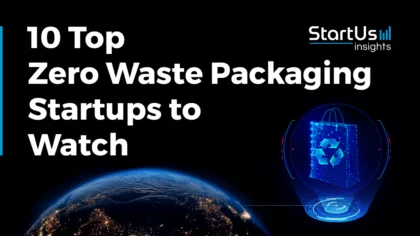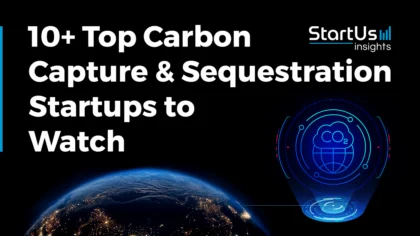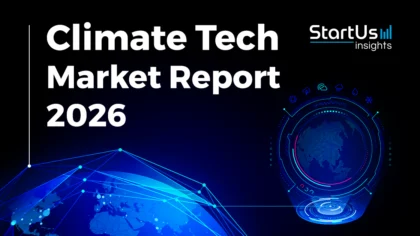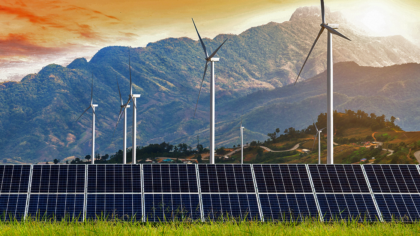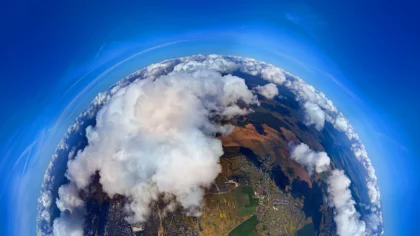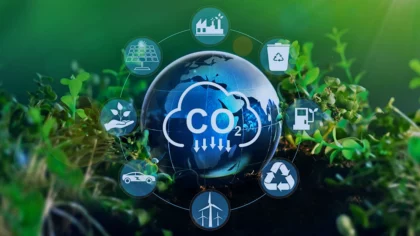Accelerate Productivity in 2025
Reignite Growth Despite the Global Slowdown
Executive Summary: What are the Top 10 Cleantech Trends in 2025 & Beyond?
The cleantech industry is improving, driven by investment, advanced technologies, and an urgent need to decarbonize across sectors. The top cleantech trends shaping 2025 and beyond are:
1. Accelerated AI Integration: Powers real-time energy forecasting, grid optimization, and smart materials R&D. It secured USD 28.5 billion in global cleantech investments to date, with an additional USD 138 billion projected by 2030.
2. Solar and Wind Energy Expansion: Solar capacity hit 597 gigawatts (GW) in 2024 and is set to reach 655 GW in 2025. Wind energy added 117 GW last year.
3. Recycling & Upcycling Innovations: AI-powered sorting robots and chemical recycling improve recovery rates, while localized modular upcycling reduces emissions.
4. Carbon Capture, Utilization & Storage (CCUS): Carbon capture capacity could reach 2.5 gigatonnes per year by 2045, with venture investment growing 139% in 2024 alone. New approaches include hybrid direct air capture (DAC) systems, ocean-based CO₂ removal, and flue gas capture.
5. Regenerative Agriculture: This market will hit USD 10.19 billion by 2025, growing at a 16.1% compound annual growth rate (CAGR). Private and public funds exceeding USD 30 billion support initiatives for soil health, biodiversity, and carbon sequestration.
6. Alternative Fuels: The alternative fuels market will grow at nearly 9.8% CAGR, with waste-to-fuel alone projected to reach USD 2.4 billion by 2030.
7. Scaling Green Hydrogen: Targets hard-to-abate sectors like steel and chemicals, with its global market set to grow from USD 9.5 billion in 2025. India’s National Mission aims for 5 million metric tons annually by 2030.
8. Green Mobility Advances: The green mobility sector will reach USD 33 billion by 2030, driven by record investments in electric vehicles (EVs), battery storage, and charging networks. Innovations in solid-state batteries, hydrogen fuel cells, and battery-as-a-service models address high upfront costs and range anxiety.
9. Reemergence of Water Treatment and Conservation Technologies: The global water treatment market will hit USD 45.15 billion in 2025 with AI-enabled real-time monitoring, advanced membranes, and decentralized treatment.
10. Bio-based Materials: This market will reach nearly USD 47.97 billion in 2025, with emerging products showing 45-73% lower lifecycle emissions than fossil-based equivalents.
Read on to explore each trend in depth – uncover key drivers, current market stats, cutting-edge innovations, and cleantech leading innovators shaping the future.
Frequently Asked Questions
How big is the cleantech market?
The global cleantech market is projected to reach USD 1.28 trillion by 2030, with a CAGR of 12.7%.
What is the next generation of clean technologies?
Next-generation clean technologies combine AI, green hydrogen, carbon capture, and circular materials, targeting global net-zero goals.
Methodology: How We Created the Cleantech Trend Report
For our trend reports, we leverage our proprietary StartUs Insights Discovery Platform, covering 7M+ global startups, 20K technologies & trends, plus 150M+ patents, news articles, and market reports.
Creating a report involves approximately 40 hours of analysis. We evaluate our own startup data and complement these insights with external research, including industry reports, news articles, and market analyses. This process enables us to identify the most impactful and future trends in the clean tech industry.
For each trend, we select two exemplary startups that meet the following criteria:
- Relevance: Their product, technology, or solution aligns with the trend.
- Founding Year: Established between 2020 and 2025.
- Company Size: A maximum of 200 employees.
- Location: Specific geographic considerations.
This approach ensures our reports provide reliable, actionable insights into the cleantech innovation ecosystem while highlighting startups driving technological advancements in the industry.
Innovation Map outlines the Top 10 Clean Technology Trends & 20 Promising Startups
For this in-depth research on the Top CleanTech Trends & Startups, we analyzed a sample of 5800+ global startups & scaleups. The Cleantech Innovation Map, created from this data-driven research, helps you improve strategic decision-making by giving you a comprehensive overview of the cleantech industry trends & startups that impact your company.
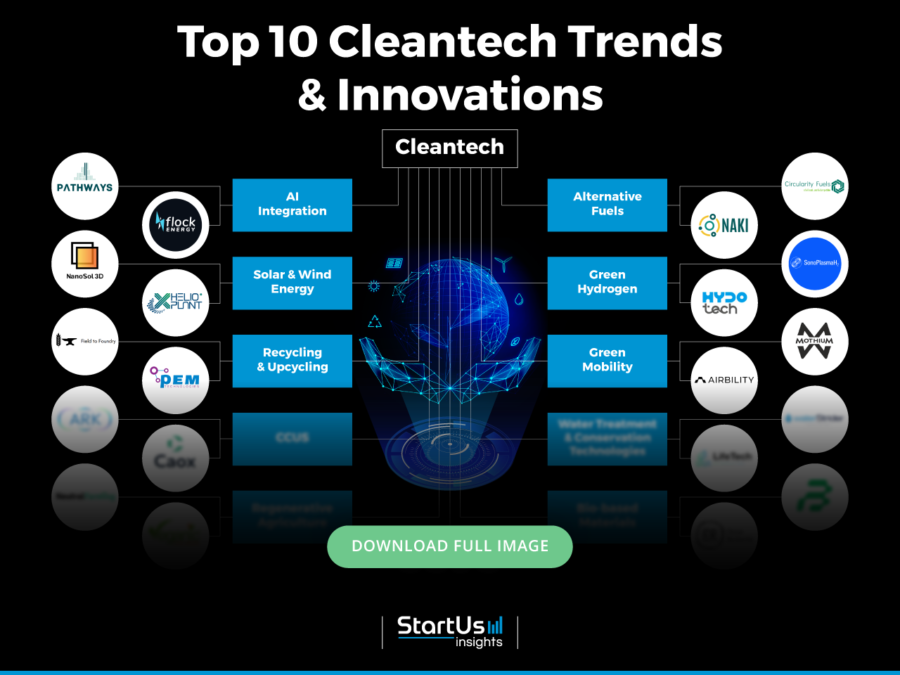
Tree Map reveals the Impact of the Top 10 Cleantech Trends
Based on the Cleantech Innovation Map, the Tree Map below illustrates the impact of the top cleantech trends. AI and advanced analytics optimize energy efficiency, renewable forecasting, and grid stability. Circular economy solutions expand with next-generation recycling, upcycling, and waste-to-fuel innovations.
Moreover, green hydrogen and alternative fuels decarbonize hard-to-abate sectors, while bio-based materials reduce emissions and enable circular production. Smart water treatment and conservation technologies address global scarcity and regulatory pressures through modular, decentralized systems.
In parallel, regenerative agriculture and green mobility solutions restore ecosystems and lower transport emissions. Carbon capture, utilization, and storage (CCUS) scale up to remove gigatonnes of CO₂, supporting net-zero goals.
Together, these advancements make cleantech systems more efficient, resilient, and accessible, and also accelerate the transition to a low-carbon, sustainable economy.

Global Startup Heat Map covers 5800+ Cleantech Startups & Scaleups
The Global Startup Heat Map showcases the distribution of 5800+ exemplary startups and scaleups analyzed using the StartUs Insights Discovery Platform. It highlights high startup activity in the USA and the UK, followed by India. From these, 20 promising startups are featured below, selected based on factors like founding year, location, and funding.
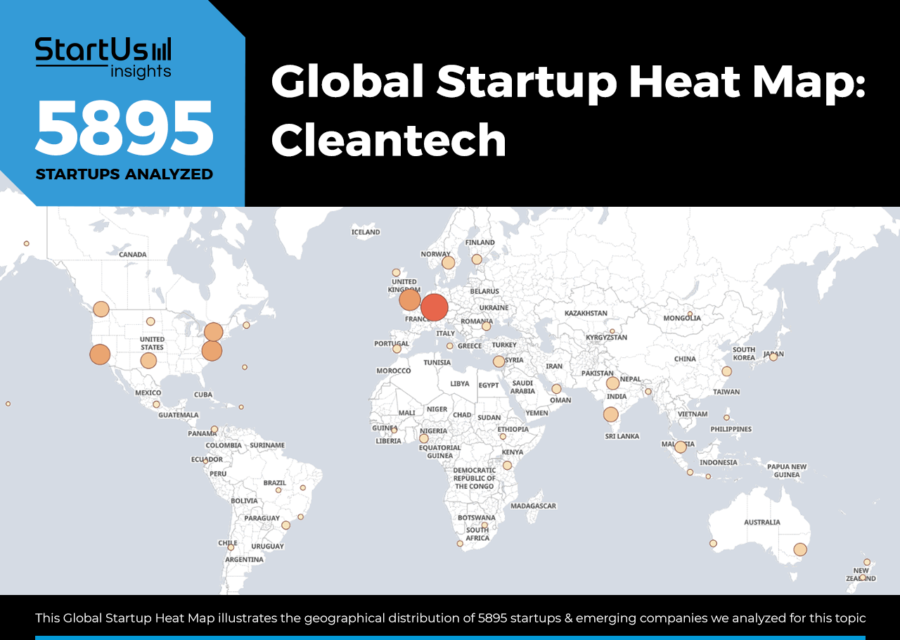
Want to Explore Cleantech Innovations & Trends?
Top 10 Emerging Cleantech Trends [2025 and Beyond]
1. Accelerated AI Integration: USD 138 B Investment by 2030
The global cleantech market is projected to reach USD 1.28 trillion by 2030, with a CAGR of 12.7%.

Credit: Grand View Research
AI-enabled solutions secured 12% of all cleantech-related contracts over the past six years and attracted USD 28.5 billion in global investment from 2018 through 2023. Industry experts estimate an additional USD 138 billion in investment will flow into AI-driven cleantech solutions by 2030 to meet global sustainability targets.
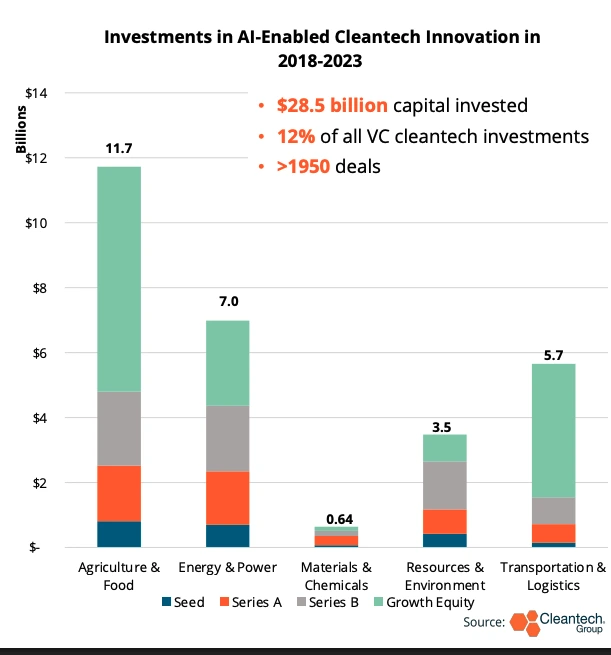
Credit: Cleantech Group
AI delivers operational impact most visibly in renewable energy forecasting, grid management, and energy efficiency. For example, Google DeepMind‘s AI-driven optimization reduced data center energy consumption by up to 40%. AI also advances grid planning and stability to reduce forecast errors and enables more reliable integration of renewable sources. On a global scale, AI could lower greenhouse gas emissions by 2.6 to 5.3 gigatonnes by 2030.
The rise of AI brings new challenges, especially its high energy and water demands. Data center power needs could grow by 160% through 2030, and training a single AI model is expected to use more electricity than 120 U.S. homes each year.
However, companies already work to tackle AI-related emissions and water use. For instance, Microsoft plans to achieve carbon-negative, water-positive AI operations by 2030, while Google targets running all AI workloads on carbon-free energy by 2030.
Further, modular and scalable AI solutions integrate with existing infrastructure to reduce the need for costly overhauls. Federated learning and privacy-preserving algorithms address data privacy concerns, while cybersecurity measures safeguard AI-driven energy systems.
Pathways offers Real-time EPD Automation
US-based startup Pathways develops an AI-powered platform that automates environmental product declarations (EPDs) for material manufacturers. The platform ingests and improves unstructured operational data from sources like procurement records, safety sheets, and invoices. It uses proprietary AI to reduce manual errors and avoid time-consuming data gathering.
Moreover, the platform integrates with the user’s company’s data infrastructure and keeps information up to date through always-active data pipelines. These pipelines reflect changes in supply chains and production processes.
Further, the user portal offers real-time visibility into plant, product, and project emissions. It also provides benchmarking, hotspot analyses, and scenario modeling to identify emissions reduction opportunities.
Flock Energy develops a Data-as-a-Service Platform
UK-based startup Flock develops AI-powered solutions that convert smart meter data into detailed, actionable energy insights for utilities and households. Its Flock Disaggregate algorithm breaks down total household energy consumption into individual appliance usage without extra hardware.
Further, the Flock Connect engine enriches this disaggregated data with weather patterns, property details, land registry records, and financial indicators. The engine also improves demographics and geospatial information to build household profiles.
This combination enables precise demand forecasting, supports theft and default prevention, identifies vulnerable customers, and unlocks demand-side flexibility.
2. Solar and Wind Energy Expansion: Solar Investments to Reach USD 450 B in 2025
In 2024, global solar installations surged to 597 gigawatts (GW) to mark a 33% increase from the previous year and push cumulative capacity beyond 2 terawatts (TW).

Credit: Solar Power Europe
Forecasts for 2025 expect solar investments to reach USD 450 billion, with annual installations expected to grow to 655 GW. By 2030, solar photovoltaic (PV) technology is expected to capture 80% of all renewable capacity growth worldwide.
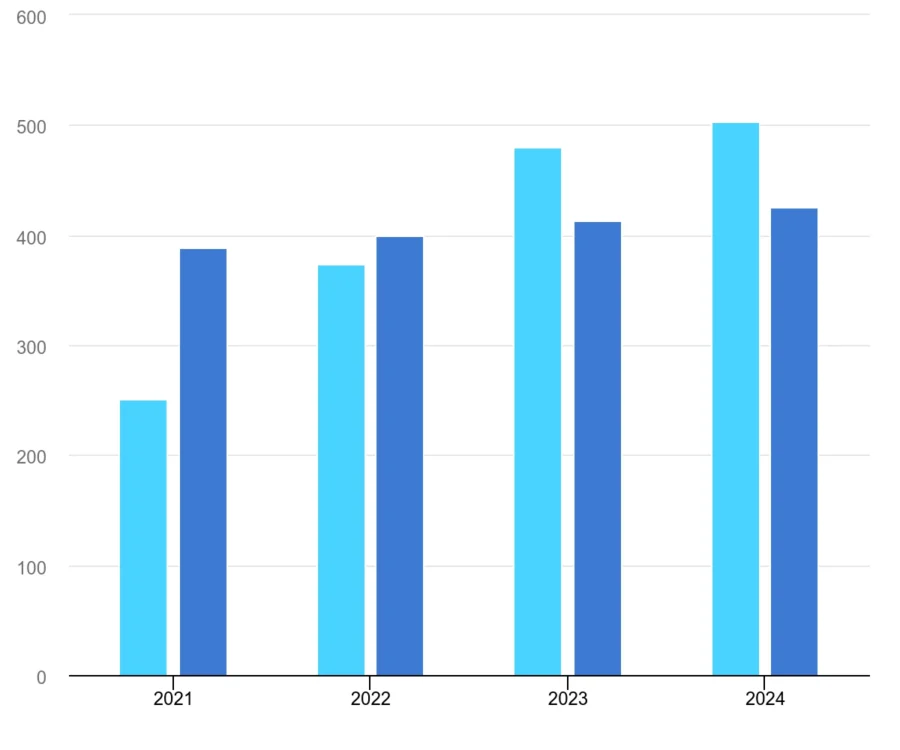
Credit: IEA
Wind energy, while experiencing slower growth relative to solar, also set a record last year with 117 GW added globally. Offshore wind capacity is forecasted to rise from 16 GW in 2025 to 34 GW by the end of the decade.

Credit: IEA
Alongside investment figures, the funding rounds highlight growing confidence in AI-driven innovations for solar and wind energy. For solar, Exowatt secured USD 70 million in Series A funding to scale AI-powered renewable solutions.
While Metris Energy raised EUR 2 million, REplace raised USD 2.1 million to expand AI platforms for commercial solar assessment and project development.
In wind, Aerones attracted USD 62 million for AI-driven robotic turbine maintenance. Further, Vind AI raised EUR 3 million in seed, and Twindo raised EUR 1 million to optimize wind park design and field operations. These investments reflect a clear trend as AI-driven solutions are improving cleantech efficiency and growth. Further, the investments are cementing solar and wind as the core drivers of the industry’s transformation.
Despite rapid growth, the solar and wind industries still face challenges such as intermittency, grid integration, supply chain issues, high upfront costs, and land use concerns.
To tackle these issues, the sector uses energy storage to balance supply and demand, and new panel and turbine designs to improve efficiency. Smart grids, better transmission, and AI-driven analytics also improve integration, supply chain resilience, and environmental monitoring.
NanoSol 3D makes Solar Glass Window
Swiss startup NanoSol 3D develops transparent solar glass windows using perovskite photovoltaic (PV) technology. It prints directly onto glass substrates to generate energy while maintaining transparency. The startup’s method applies conductive layers to create gaps within each cell for allowing visible light to pass through.
Moreover, it combines this PV innovation with industrial-scale 3D printing solutions that handle the entire process from prototyping to production. It further integrates clean energy generation into building facades without compromising natural light or aesthetics.
Helioplant Engineering develops Mountain Solar Systems
Austrian startup Helioplant Engineering builds Helioplant, which is a self-regulating photovoltaic system that generates energy in mountain regions. The system’s cross-structure design uses wind currents to keep PV elements clear of snow. It also creates crater rings that maintain stable output even during harsh winter conditions.
Additionally, the system increases efficiency by combining twin-faced modules with ground gaps that reflect light through thin snow layers.
3. Recycling & Upcycling Innovations: 20-25 M Tons of Plastic to be Processed Annually by 2030
By the year 2030, advanced recycling technologies are expected to handle between 20 and 25 million tons of plastic waste each year. This amount of recycled plastic will account for around 5-7% of global plastic production. Advanced recycling will handle 20-25 million tons of plastic waste per year by 2030. Investment in these sectors since 2020 surpasses USD 7.5 billion.
Recent funding rounds include MacroCycle‘s USD 6.5 million seed round in early 2025 for commercializing low-energy plastic upcycling. Hubcycle also received a USD 16.2 million Series A investment in late 2024 for scaling food industry byproduct upcycling.
Despite this investment in growth, less than 9% of global plastic waste is recycled into new materials. The rest ends up incinerated, landfilled, or polluting the environment. Also, the key obstacles include waste contamination, immature supply chains, high processing costs, and inconsistent demand for recycled materials.
To address these barriers, the cleantech sector deploys advanced technologies. AI-powered sorting and robotic systems automate waste identification and separation. They increase efficiency and reduce contamination. The recycling robot market alone is expected to grow up to USD 673.21 million by 2032.
Chemical recycling and processes like hydrochemolytic technology break down waste at the molecular level to upcycle previously unrecyclable materials.
Additionally, localized upcycling and modular solutions, such as mobile processing units near manufacturing sites, reduce transportation emissions. These solutions also strengthen regional economies.
Policy and regulatory support this progress. Extended producer responsibility schemes and plastic credits encourage more investment in recycling infrastructure and create stable demand for recycled materials.
Field to Foundry converts Waste to Aromatic Carbon
Australian startup Field to Foundry makes circular carbon biotechnology that converts organic waste into aromatic carbon feedstock for industrial use.
It uses precision fermentation with melanitic fungi to convert high-carbon organic waste, including distillers’ dried grains. This process produces concentrated polymeric phenolic carbon without heat or intensive energy input.
Further, this feedstock comprises fewer impurities than conventional biomass-derived options and reduces reliance on coking coal, graphite mining, or energy-intensive carbon capture.
The resulting aromatic carbon supports applications across steel production, batteries, refractories, electrodes, and advanced composites. It also offers agricultural and environmental benefits such as soil carbon stabilisation and heavy metal absorption.
PEM Technologies offers Proton Exchange Membrane (PEM) Water Electrolysis
UK-based startup PEM Technologies makes a PEM water electrolyzer that converts recyclable waste into a sustainable feedstock for clean hydrogen production.
The startup’s PEM technology breaks down water into hydrogen and oxygen gas using renewable energy. It offers a dynamic load response that supports zero-carbon hydrogen output.
The technology further removes the need for rare earth minerals and sources materials locally from industrial waste streams.
4. CCUS: CO2 Capture Capacity to Reach 2.5 Gigatonnes Annually
The global capture capacity of the CCUS segment is projected to reach 2.5 gigatonnes per annum by 2045, with a CAGR of 18.5% from this year onwards. By 2030, the current project pipeline indicates annual CO2 capture capacity could reach around 95 Mt from hydrogen production and 90 Mt from power generation.
Further, the CCUS capture capacity is projected to reach 50 Mt from industrial facilities like cement and steel, and 65 Mt from DAC plants. However, only 20% of this announced capacity was either operational or had reached a final investment decision as of February 2024.

Credit: Oliver Wyman
Venture capital investment also surged by 139% to reach USD 700 million, with the deal count increasing by 80% over 2023.
Governments also ramp up commitments, with the European Union channeling EUR 1.5 billion toward CCUS projects and over USD 500 million for CO2 transport and storage. Alongside, the UK pledged up to GBP 21.7 billion over 25 years for its major CCUS initiatives.
Additionally, companies attract both private and public capital to grow the segment. For instance, CarbonCapture raised USD 80 million to expand its modular direct air capture systems.
Avnos also secured USD 36 million for its energy-efficient hybrid DAC technology, which also produces water as a byproduct. Likewise, Captura closed USD 45.3 million for its ocean-based CO2 removal with electrodialysis.
Despite these advances, the industry faces hurdles like high capital costs, limited financial incentives, regulatory complexity, infrastructure gaps, and public skepticism.
Also, the emerging technological solutions include advanced metal-organic frameworks (MOFs), direct air capture systems, and CO2 utilization pathways. These technologies improve efficiency and lower costs, with one lab test reporting up to 99% CO2 removal and 19% cost reductions with amine scrubbing.
ARK Capture Solutions makes Flue Gas Capture Technology
Belgian startup ARK Capture Solutions makes a hybrid carbon capture technology that removes CO2 from industrial flue gases at low cost and high efficiency. Its full-electric system sits downstream of point source emissions and uses renewable energy to produce high-purity CO2 for utilization or storage.
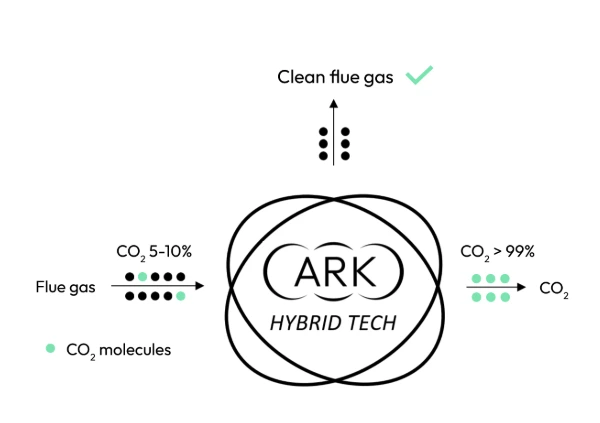
Credit: ARK Capture Solutions
The technology’s features include low energy consumption, a small footprint, and autonomous operation without chemicals or hazardous materials. It works even with low levels of CO2 concentrations. This feature makes it effective for industries like gas-fired plants, petrochemicals, glass, and steel production.
Caox converts CO2 to Non-Toxic Mineral
Norwegian startup Caox develops a carbon capture and utilization technology. This technology converts carbon dioxide and industrial waste into high-purity, non-toxic minerals.
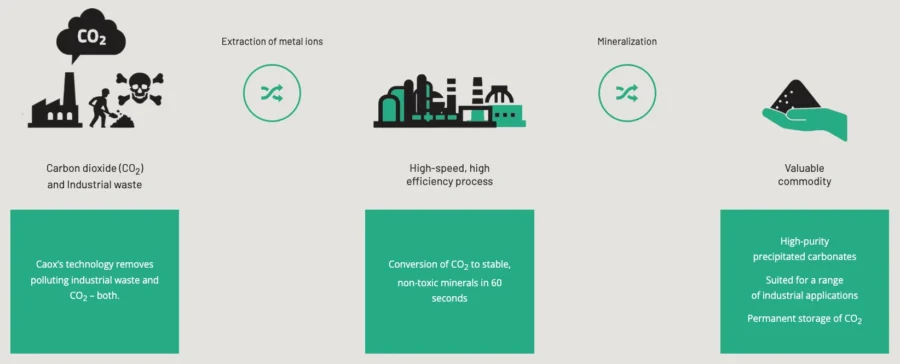
Credit: Caox
Its process extracts metal ions and mineralizes CO2 within 60 seconds to create precipitated carbonates that are suitable for industrial applications. The technology also ensures permanent carbon storage.
This high-speed, high-efficiency approach removes polluting waste streams and reduces carbon dioxide emissions. It further offers permanent carbon storage to mitigate climate change.
5. Regenerative Agriculture: A USD 10.19 B Market in 2025
Over 60% of EU agricultural soils and 40% of UK soils are facing severe degradation. Hence, environmental benefits like improved soil health and carbon sequestration take on greater importance across the sector.
The market value of regenerative agriculture is projected to reach USD 10.19 billion in 2025. Investments in sustainable agriculture, including regenerative practices, are forecasted to surpass USD 30 billion globally in 2025. Within this, regenerative agriculture accounts for around USD 3.1 billion.
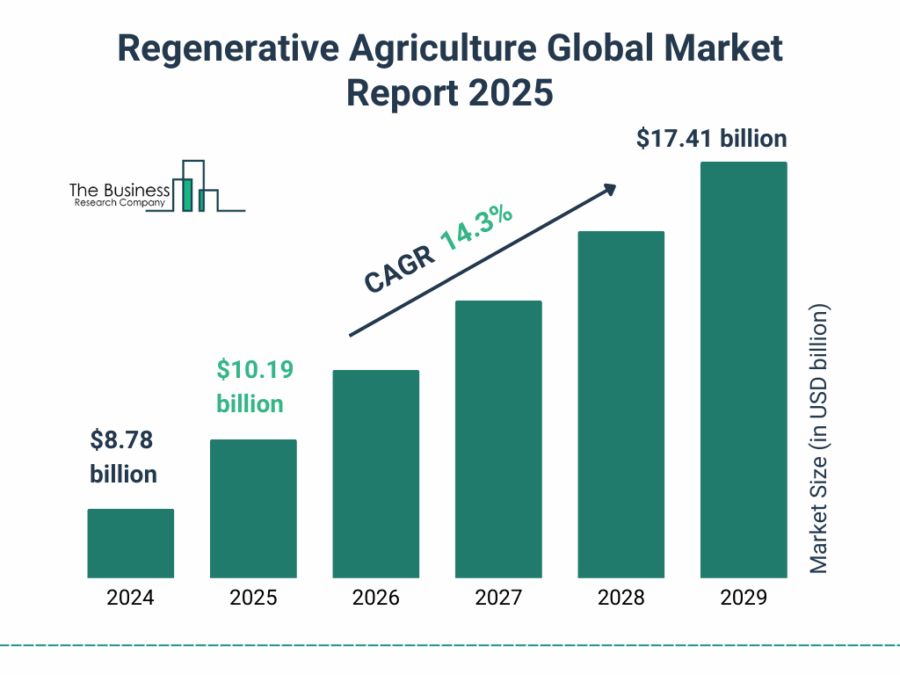
Credit: The Business Research Company
Moreover, the private sector in the USA deployed nearly USD 50 billion into sustainable farmland and regenerative projects as of 2024.
On the other hand, public initiatives like the United States Department of Agriculture (USDA) invested about USD 3 billion in climate-smart farming. Similarly, the Environmental Protection Agency (EPA) put USD 20 billion through the Greenhouse Gas Reduction Fund.
In the first quarter of 2025, global commitments to regenerative agriculture and food system projects topped USD 1.17 billion. Regenerative methods also deliver measurable impact, with farmers reporting yield increases of up to 20% and input cost reductions between 10%-30%.
Notable companies receiving investments include Klim, which is a German AgTech company. It secured USD 22 million in a Series A round to expand its digital tools and farmer support services for regenerative agriculture transitions.
Mad Capital, for instance, launched its Perennial Fund II with USD 50 million to provide financial solutions that assist farmers in adopting regenerative practices.
Further, technologies like precision agriculture, soil sensors, and AI-powered analytics overcome these industry challenges. For instance, transitioning to regenerative practices presents obstacles. This includes high upfront costs, complex measurement and reporting requirements, supply chain fragmentation, and gaps in technical knowledge.
So, advanced solutions like AI-powered digital extension services, soil mapping, biogas and biofertilizer technologies, and blockchain-enabled supply chain transparency address these barriers.
Neutral Farming builds a Soil as a Service Platform
Chilean startup Neutral Farming builds a soil-as-a-service platform that combines satellite scanning, AI, and machine learning (ML) with scientific soil monitoring.
The platform measures baseline and potential carbon sequestration, tracks biological, chemical, and physical soil data. It also provides insights through a dashboard with georeferenced maps and field stratification.
Additionally, the platform supports modules for greenhouse gas emissions calculation, insetting reports, and verified carbon credit generation.
It further assists fruit growers with monitoring, recommendations, and reporting tools. These tools enable farmers to restore soil health, unlock CO2 sequestration potential, and transition toward sustainable production systems.
Veganic provides Sustainable Agricultural Platforms
Spanish startup Veganic offers Neo-Prime, Neo-Duo, and MicroGea. These are agricultural technologies that strengthen plant health, increase yields, and support sustainable farming.
Neo-Prime activates plants’ natural immune responses with a priming effect. It enables faster, more resilient reactions to pests, pathogens, and extreme weather, reduces chemical dependence, and maintains crop quality.
Neo-Duo uses a double-absorption technology to enhance nutrient uptake and energy efficiency. It lowers water and input needs while improving plant performance and minimizing environmental impact.
Further, MicroGea applies precision microbial technology with customized endophytic strains. It optimizes nutrient use efficiency, improves fertilizer uptake, and maintains a healthy soil microbiome throughout the crop cycle.

6. Alternative Fuels: Waste-to-Fuel Market to Reach USD 2.4 B by 2030
Alternative fuels play an important role in reducing carbon emissions across transportation, industrial, and power sectors. The global alternative fuels market is valued to approach USD 512.4 million by 2030 at a CAGR of 9.8%. Moreover, waste-to-fuel technologies stand with the market projected to value at USD 2.4 billion by 2030 at a CAGR of over 30.7%.
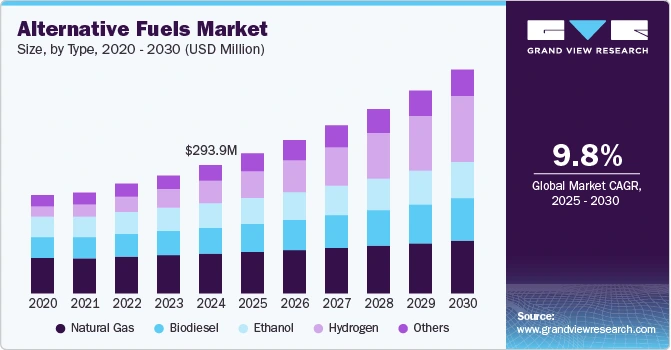
Credit: Grand View Research
Funding for biofuels, biogases, and low-emission hydrogen is expected to increase by nearly 30% in 2025. For instance, the maritime sector saw 50% of new shipbuilding tonnage ordered in 2024 with alternative fuel capabilities. It amounted to 820 vessels and 62.2 million gross tons.
Venture capital also flows into the sector, with initiatives like the NextSTEP VC fund allocating EUR 1.6 million for 16 new cleantech investments in 2025.
However, the alternative fuels industry faces challenges, including high capital expenditure required for manufacturing, infrastructure, and supply chains of hydrogen and biofuels.
Moreover, the lack of refueling and distribution networks remains a barrier to widespread adoption. Feedstock volatility that is driven by fluctuating prices and supply of raw materials like agricultural waste and algae further complicates biofuel production.
To overcome these challenges, the industry leverages technologies such as waste-to-fuel or hydrogen and ammonia. Such processes convert municipal solid waste, agricultural residue, and industrial by-products into bioethanol, biodiesel, and renewable natural gas. Hydrogen produced via electrolysis and ammonia emerge as key fuels for shipping and power generation.
Green Plains is also advancing its biofuel and carbon capture efforts. It plans to permanently sequester up to 1.2 million tons of biogenic CO2 annually from its Nebraska facilities. In India, Green Joules raised USD 4.5 million to produce biofuels from agricultural waste.
Similarly, Amogy received investment of USD 56 million in early 2025 to commercialize its ammonia-to-power technology for the shipping and heavy industries.
Likewise, Infinium Holdings secured up to USD 1.1 billion from Brookfield to scale up e-fuel production and support the decarbonization of transport.
Circularity Fuels converts CO2 to Hydrocarbon Fuel
US-based startup Circularity Fuels builds reactors and catalytic technologies that convert waste CO2 and clean energy into renewable hydrocarbons compatible with existing fuel infrastructure.
Its Triple C Catalyst produces the desired hydrocarbon without requiring expensive downstream refining. Similarly, the Ouro Reactor architecture continuously recycles atmospheric CO2 in a closed loop.
Further, the startup’s processes offer products like diamond-grade methane, sustainable aviation fuel, and renewable diesel from sources. This involves biogas, manure emissions, and stranded renewable energy. Thus, the startup replaces fossil fuels with fuels made from waste carbon streams at lower costs and with reduced emissions.
Naki provides Carbon-Negative Sludge to Fuel
Israeli startup Naki develops a modular chemical processing technology that converts sludge waste with high fat or oil content into feedstocks for sustainable aviation fuel (SAF) and biogas.
Its process uses a reaction powered by a recyclable catalyst that operates at room temperature inside a compact, containerized unit.
The technology handles sludge sources, such as dissolved air flotation and centrifuge-processed waste. It also produces MIDA Oil for SAF and clean solids for biogas applications.
Naki’s automated, low-maintenance setup further integrates with existing waste collection and feedstock supply chains. Thus, it allows food processing plants, slaughterhouses, and oil-based manufacturing facilities.
7. Scaling Green Hydrogen: A USD 9.5 B Market in 2025
Green hydrogen decarbonizes hard-to-abate sectors such as steel, chemicals, refining, and heavy transport. The global green hydrogen market is projected to reach USD 9.5 billion in value by 2025 and USD 70 billion by 2030.
For example, the Indian government’s National Green Hydrogen Mission plans to produce at least 5 million metric tons of green hydrogen annually by 2030. This is supported by an investment of over INR 8 lakh crore, and the mission creates more than 600 000 jobs.
Moreover, the global installed water electrolyzer capacity reached 5 GW by the end of 2024, which is an increase from 1.4 GW at the close of 2023. However, less than 1% of the 97 Mt of hydrogen produced worldwide in 2023 was considered low-emission despite these figures.
The industry faces critical challenges like high production costs, insufficient infrastructure for hydrogen transport and storage, and delays in grid connectivity. Many announced projects were yet to reach final investment decisions, and less than 7% of global electrolytic capacity had passed this stage as of May 2024.
The green hydrogen domain relies on proton exchange membrane (PEM) and solid oxide electrolyzers to offer higher efficiency and flexibility with variable renewable energy inputs.
Innovations in hydrogen storage and transport, including ammonia conversion for shipping and leveraging existing infrastructure, also speed up deployment.
For instance, Adani New Industries invested USD 50 billion toward a target of 1 million tons of green hydrogen production by FY27.
Additionally, Acme Cleantech invested over USD 3 billion in green ammonia projects, and Hy2gen received EUR 47 million in a funding round led by Hy24 to deploy green hydrogen and ammonia projects.
SonoPlasmaH2 develops Plasma Sonolysis Technology
Estonian startup SonoPlasmaH2 develops a plasma-sonolysis (PESRH) reactor. It produces green hydrogen at twice the energy efficiency and three times the lower of traditional electrolysis methods.
Its PESRH technology combines plasma and ultrasonic processes to split water molecules using less energy. This reduces operational expenses and capital costs.

Credit: SonoPlasmaH2
The reactor uses renewable energy sources and works with variable power inputs. Thus, it integrates with wind and solar power to balance supply and demand.
Moreover, the technology removes reliance on fossil fuels and pure water and lowers environmental impact. It also provides high-purity hydrogen for industries like chemical manufacturing, steel production, and ammonia synthesis.
HydoTech builds Alkaline Electrolyzer
German startup HydoTech develops green hydrogen production systems on proprietary alkaline electrolysis technologies.
Its standardized square-shaped cells feature an optimized flowfield and integrated cell voltage monitoring for real-time diagnostics. Its cartridge stack design offers 1.6 MPa (megapascal) hydrogen output pressure with cell change and upgrade capabilities.
The startups’ HydoOS digital platform provides remote monitoring, cloud-based diagnostics, and digital twin functionality for system management across diverse renewable energy applications.
It further combines modular plug-in stacks, intelligent sensing, and industrial-grade big data architecture to produce and utilize green hydrogen for reducing costs and emissions.
8. Green Mobility Advances: Market to Hit USD 33 B by 2030
Recent market forecasts project the global green mobility sector to surge to USD 33 billion by 2030 with a CAGR nearing 11%. Although in Europe, cleantech venture capital investments, including green mobility, declined from EUR 11.6 billion in 2023 to EUR 8.8 billion in 2024.
For example, Verkor received EUR 2 billion for battery production. India committed USD 500 million to its electric vehicle industry. The public and private initiatives target USD 900 million to deploy over 50 000 e-buses by 2029.
The battery-as-a-service market in India anticipates revenues of USD 30.19 billion by 2030. Electrified transportation and renewables each attracted over USD 600 billion in 2023.
Policy support also improves industry progress. The EU Innovation Fund allocated up to EUR 3.4 billion for net-zero technologies and EV battery manufacturing in 2024, with 373 project proposals submitted.
India’s National Manufacturing Mission prioritizes clean tech manufacturing, EV batteries, and green energy. It targets 500 GW of green energy capacity and a 45% reduction in emissions intensity by 2030. Such initiatives drive decarbonization, job creation, and sustainable economic development.
However, high upfront costs deter over 60% of potential electric vehicle buyers. Inadequate charging infrastructure and range anxiety persist as adoption barriers.
GreenCell Mobility, which is an electric mobility platform, invested INR 15 billion to deploy 1200 additional electric buses. Additionally, Northvolt secured a German state subsidy of EUR 902 million for the construction of a new battery factory.
Reliance on minerals from limited geographies also introduces supply chain vulnerabilities and regulatory inconsistencies that slow infrastructure development. The transition away from fossil fuels also disrupts existing tax revenues and demands substantial capital investment.
Mothium makes Electric Cargo Vehicles
Spanish startup Mothium designs electric cargo vehicles that combine the agility of a bicycle with the utility and comfort of a delivery van for urban logistics.
Its electric power-assisted cycle (EPAC) cargo bikes use automotive-grade components, lithium iron phosphate (LFP) batteries, and a motor offering up to 560 Nm of torque to handle steep slopes under full load.
Further, the pedal-by-wire system removes mechanical cables for smoother control. While the vehicle control unit (VCU) core and drivetouch display manage keyless access, diagnostics, and smart connectivity.
Each vehicle integrates the Mothium Synapse platform, which uses advanced control, ML, and IoT to adapt and perform reliably. With durable construction and active cooling options for fresh or frozen cargo, Mothium lowers operating costs and ensures comfort and safety for drivers.
AIRBILITY provides Advanced Air Mobility
South Korean startup AIRBILITY provides advanced air mobility solutions that merge vertical takeoff and landing (VTOL) capabilities with high-speed flight for urban and rural connectivity.
Its AB-U60 aircraft integrates four tilt-electric ducted fan systems that double cruising speed for efficient transition from takeoff to cruise.
The fuselage-mounted quad-electric fanjet system optimizes weight distribution for stable operation. Further, its distributed electric fanjet system scales across different aircraft sizes using a single fanjet design.
Further, the hybrid energy system also supports low-emission, long-range flights, and its flight control software ensures smooth transitions and fail-safe modes.
9. Reemergence of Water Treatment and Conservation Technologies
The global water treatment systems market is projected to reach USD 45.15 billion in 2025. With a CAGR of 8.15%, the sector will reach USD 91.39 billion by 2034. The Asia Pacific region led the market in 2024 that accounting for 36% of global share, largely due to rapid urbanization and acute water scarcity challenges.
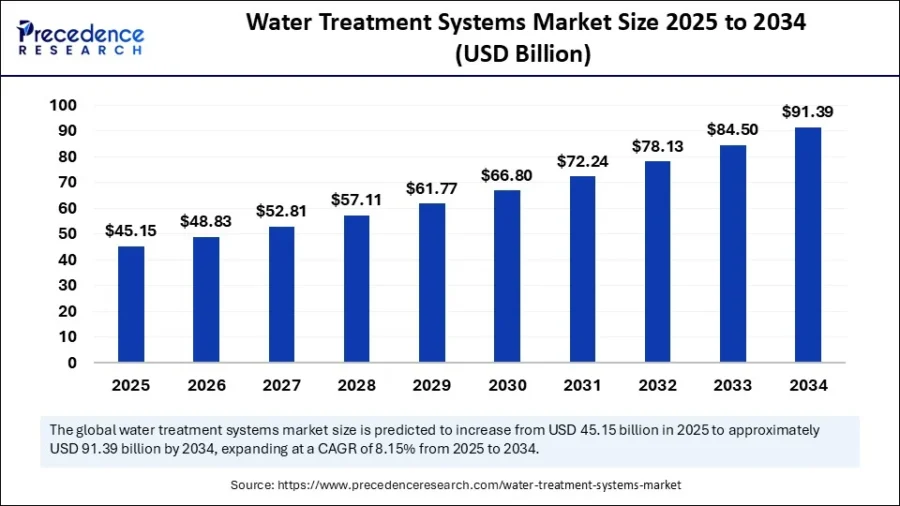
Credit: Precedence Research
Notably, India’s National Mission for Clean Ganga approved 39 new projects worth around INR 2056 crore in 2024. It contributed to a cumulative total of 488 projects valued at nearly INR 39 730 crore. Additionally, the nanofiltration membrane market is projected to grow to USD 3.01 billion by 2032 with a CAGR of 10%.
However, the industry faces challenges like the need for real-time water quality monitoring, improving treatment efficiency, and ensuring compliance with stricter environmental standards.
Latest solutions include nanofiltration and reverse osmosis, decentralized and modular treatment systems, IoT-enabled smart water monitoring, and nature-based methods using microbes and algae.
Additionally, innovations in solar-powered and energy-efficient treatment processes, as well as advanced desalination techniques, are making headway.
The segment also witnesses a change toward circular economy principles, with startups focusing on water reuse, nutrient recovery, and integrated waste management for industrial clients.
Gradiant raised USD 225 million in Series D funding for its AI-driven water treatment technologies, and Uravu Labs secured USD 2.3 million for its solar thermal water-from-air systems.
Genesis Systems raised USD 25.3 million in 2025 to advance its renewable water technologies. Likewise, ZwitterCo closed a USD 58.4 million Series B in 2024 to speed up deployment of its advanced membrane technology for industrial wastewater.
waterStrider provides Water Treatment Solutions
Canadian startup waterStrider develops integrated mine water treatment technologies that remove toxic metals and contaminants. The Amprey electrochemical cell treats mine-impacted water by converting dissolved metals into stable solids without generating hazardous waste.
Similarly, Misty CO2 captures CO2 from exhaust and uses it for safe, low-cost pH neutralization. It also replaces strong acids and generates carbon credits.
Complementing these, MikroForme uses micro-bubble flotation to lift solids for easy separation and dewatering, minimizing chemical inputs and reducing operating and capital costs. Thus, waterStrider combines electrochemical removal, carbon capture and utilization, and advanced flotation in a modular, scalable approach.
LifeTech Water Solutions offers High Frequency Ultrasound Water Treatment
German startup LifeTech Water Solutions makes high-frequency ultrasound water treatment systems that remove bacteria, viruses, microplastics, per- and polyfluoroalkyl substances (PFAS), medical residues, and hormones without chemicals. Its technology also generates cavitation bubbles that create intense microscopic heat and pressure.
Further, it breaks down organic and inorganic pollutants while converting microplastics into harmless carbon. The design integrates microbubble reactors, LED UV-C lamps, ozone enrichment, desalination, and filtration to purify drinking water, industrial water, or wastewater.
10. Bio-based Materials: Market to Reach USD 106 B by 2029
Bio-based materials reduce environmental impact and greenhouse gas emissions while supporting the circular economy. The bio-based materials market size is projected to reach USD 47.97 billion in 2025 with a CAGR of 25.7%. Forecasts suggest the market will reach USD 106.69 billion by 2029, with a projected CAGR of over 22.1%.
After a correction in 2023, global funding for biomaterials rebounded in 2024 by reaching USD 583 million. The first quarter of 2025 alone saw USD 392 million in investments for a potential year-end total of USD 1.5 billion.
A few recent investments include Tidal Vision‘s USD 140 million Series B round for chitosan-based materials used in water treatment and flame retardants. Pulpex, for instance, received GBP 62 million in Series D funding for fiber-based packaging innovation. Also, Bloom Biorenewables received USD 15 million to scale lignin-based chemicals and solvents.
On average, emerging bio-based products have 45% lower life cycle greenhouse gas emissions than fossil-based counterparts. Some biorefinery products achieve up to 73% lower emissions. The European Commission estimates that widespread adoption of bio-based products could save up to 2.5 billion tons of CO2 equivalent annually by 2030.
In the chemical sector, the shift to biobased alternatives for key petrochemicals is expected to reduce industry-wide greenhouse gas (GHG) emissions by 19%.
However, high production costs, largely driven by expensive and inconsistent feedstock supply, remain a major barrier. For instance, feedstock expenses account for up to 70% of total production costs. Scalability stands as another hurdle, as many biobased technologies have yet to reach mass production levels.
Companies like LignEasy and Sonichem provide separation and conversion technologies, while UBQ Materials converts mixed municipal waste into thermoplastics.
Bioplastix develops AI-driven Microbial Biopolymers
Mexican startup Bioplastix develops an integrated bioplastics production technology that uses engineered E. coli bacteria to produce high-performance biopolymers.
With precision fermentation and enzyme optimization, its microbes consume low-cost sugars and agroindustrial waste as feedstock. This lowers raw material expenses while optimized metabolic pathways streamline purification and reduce downstream processing expenses.
The technology further adjusts monomer ratios in real time to deliver tailored polylactic acid (PLA) and polyhydroxybutyrate (PHB)-based bioplastics with improved thermoplastic properties and expanded biodegradability.
Ocean Recherche makes Marine-derived Materials
French startup Ocean Recherche develops marine-based materials that convert seafood waste and bio-derived polysaccharides into high-performance textile solutions.
Its Sei material uses a nano-structured approach to optimize strength and flexibility for applications like fibers and coated canvas. Similarly, SeiYarn offers a silk-like staple fiber that is recyclable, naturally antimicrobial, and dyeable.
Additionally, the SeiShell material offers a coated canvas alternative to leather with high durability, flex resistance, and abrasion performance. It is crafted directly from seafood waste.
Discover all CleanTech Trends, Technologies & Startups
As the cleantech industry evolves, alternative fuels will become a key competitive differentiator for companies to reduce emissions and meet climate targets.
The integration of innovative production technologies, smart supply chains, and circular economy principles will reshape the production, distribution, and resources. Businesses that invest in such solutions today are expected to thrive in a carbon-conscious, resource-efficient economy.
The Cleantech Trends & Startups outlined in this report only scratch the surface of the trends that we identified during our data-driven innovation & startup scouting process. Identifying new opportunities & emerging technologies to implement into your business goes a long way in gaining a competitive advantage.
![Uncover the Top 10 Cleantech Trends & Innovations [2025-2026]](https://www.startus-insights.com/wp-content/uploads/2025/07/Cleantech-Trends-SharedImg-StartUs-Insights-noresize-1-420x236.webp)


